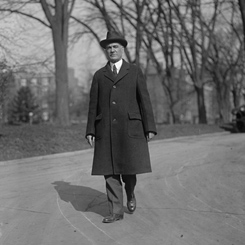 Image courtesy of Library of Congress
Elected to 11 terms in the House of Representatives, John Q. Tilson of Connecticut served as the Republican Majority Leader from 1925 to 1931.
Image courtesy of Library of Congress
Elected to 11 terms in the House of Representatives, John Q. Tilson of Connecticut served as the Republican Majority Leader from 1925 to 1931.
On this date, the House passed the
Permanent Apportionment Act of 1929, fixing the number of Representatives at 435. The U.S. Constitution called for at least one Representative per state and that no more than one for every 30,000 persons. Thus, the size of a state’s House delegation depended on its population. But the founders were vague as to how large future Congresses should be and what method to use to reapportion the House after each federal census. These questions vexed Congress for much of its history as U.S. territories expanded and the population grew. Usually, the House reapportioned itself in a manner that expanded, or at least preserved, the representation of most states. Gradually, however, the method for calculating apportionment caused smaller rural states to lose representation to larger urbanized states. A battle erupted between rural and urban factions, causing the House (for the only time in its history) to fail to reapportion itself following the 1920 Census. Signed into law on June 18, 1929, the Permanent Apportionment Act capped House Membership at the level established after the 1910 Census and created a procedure for automatically reapportioning House seats after every decennial census. Republican
Majority LeaderJohn Q. Tilson of Connecticut approvingly declared that the act dispelled “the danger of failing to reapportion after each decennial census, as contemplated by the Constitution.” But opponents, such as
William B. Bankhead of Alabama, who doubted its constitutionality, described the plan as “an abdication and surrender of vital fundamental powers.” In 1941, Congress adopted the current formula for reapportioning House seats.
 Image courtesy of Library of Congress
Elected to 11 terms in the House of Representatives, John Q. Tilson of Connecticut served as the Republican Majority Leader from 1925 to 1931.
Image courtesy of Library of Congress
Elected to 11 terms in the House of Representatives, John Q. Tilson of Connecticut served as the Republican Majority Leader from 1925 to 1931.










